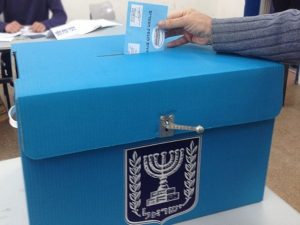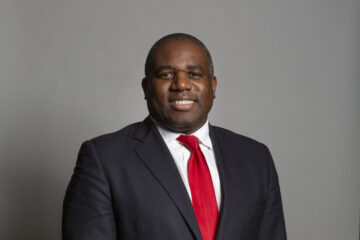
Photo: Heinrich-Böll-Stiftung, CC BY-SA 2.0 via Wikimedia Commons
With only days remaining until Israel’s political parties must present their finalised slates for September’s general election, there has been further maneuvering on the left and right, and between Arab parties.
Two weeks ago, the Labor party announced that it had agreed a merger with Orly Levy-Abekasis’s Gesher party. The move was widely seen as a shift to the centre ground.
Last week, one of Labor’s leading lights – former leadership contender Stav Shaffir – announced she was quitting the party and joining a new alliance of left-wing parties.
Within the past few days, the right-wing New Right and Union of Right-wing parties have agreed an electoral pact.
Last weekend also saw four Arab parties announce the reformation of the Joint List, a potentially potent alliance which won third place in terms of Knesset seats in the 2015 general election, but splintered before April’s poll.
For several weeks, there had been speculation about the formation a left-wing grouping including, Labor, the Meretz party, and the newly formed Israel Democratic party of former prime minister Ehud Barak.
However, hopes appeared to flounder when Amir Peretz announced a deal instead with Levy-Abekasis and ruled out any pact with Meretz and Barak. Labor’s new leader had previously spoken warmly of some form of agreement. The alliance with Gesher suggested instead a play for support from working-class Mizrahim, Jews who hail from Arab or Muslim countries, and who have long been the bedrock of Benjamin Netanyahu’s Likud party.
Peretz’s decision provoked concern from Shaffir and Labor MK Itzik Shmuli. The pair, who both ran against Peretz in Labor’s primary election, were strong advocates of an agreement with Meretz and the Israel Democratic party. Shaffir argued: “The merger that would bring the biggest success would be joining the three parties together, without of course losing the identity of each party”. “In the current situation,” Shaffir warned, “one party or even two in our [left] camp are likely to fall under the threshold. It is quite simply a danger to precious seats for the left that we must not allow.”
Shaffir’s words reflected predictions from analysts that three left-wing parties – Meretz, the Israel Democatic party and Labor – running in competition with each other risked only two of them crossing the threshold to enter the Knesset thus “wasting” thousands of votes and potentially costing the centre-left the opportunity to oust Netanyahu from power.
Last week, Shaffir jumped ship, and joined with Barak and Meretz leader Nitzan Horowitz in announcing the alliance – named the Democratic Camp – she had long advocated. The trio are also attempting to convince former foreign minister Tzipi Livni, whose Hatnua party formed the Zionist Union with Labor prior to the 2015 election, to return to politics to lead the alliance.
“The Labor party is my home,” Shaffir said at the launch announcement, “but the home is on fire, the neighbourhood is on fire, the country is on fire. When your home is on fire, you step outside. Then you start to rebuild it.”
Barak deemed the formation of the alliance “the first step toward getting Israel back on track, replacing the government and safeguarding Israel as Zionist, Jewish and democratic”. Horowitz vowed that the Democratic Camp would oppose the “racism, corruption, occupation and religious coercion” of the Netanyahu government.
The Democratic Camp, Barak said, would fight inequality, work toward peace with the Palestinians and defend Israeli democracy through the Supreme Court and the media. The alliance made clear that it would not enter a right-wing government under any circumstance.
Three polls taken in the wake of the announcement showed the Democratic Camp winning between 8-12 Knesset seats, overtaking Labor which drops from its current six seats to five.
Meretz has secured four of the top six slots on the alliance’s slate, with Shaffir placed at No.2. Barak opted to take the 10th place, yielding his place higher up to the former IDF deputy chief of staff Yair Golan who will run for the third spot.
After initially hinting that he might follow suit, Shmuli announced on Sunday that he was sticking with Labor, while continuing to suggest he would have preferred the party join the new left-wing alliance. The announcement followed reports that the centrist Blue and White party – the main opposition party, led by former IDF head Benny Gantz – had been wooing Shmuli and asking him to run on their slate.
Peretz, meanwhile, was reportedly meeting with members of the Democratic Camp, raising speculation that he might be planning a change of tack. He is said to have suggested that Labor would be open to joining it if would help the centre-left secure a Knesset majority. However, Peretz has also stated he wished to remain apart from the Democratic Camp as “our way gives a chance to bring votes from the right”.
Shaffir’s estrangement from Labor may not be long-lasting. As one commentator noted, when Peretz lost the Labor leadership election in 2013, he quit the party and helped Livni form Hatnua. Two years later, he was part of the newly formed Zionist Union, and four years after that elected Labor leader.
The left’s potential allies in the effort to defeat Netanyahu, the four parties representing most Arab-Israeli voters, have also announced a joint slate. The four – Balad, Hadash, Ta’al and Ra’am – represent a mix of socialist, Arab nationalist and Islamist standpoints.
In 2015, as the Joint List, they captured the votes of 82 percent of Israeli Arabs (who constitute a fifth of Israel’s population) and became the third largest group in the Knesset with 13 seats. But the alliance splintered in a row over positions on the slate in the run-up to this year’s general election. Running separately as Hadash-Ta’al and Ra’am-Balad, the two slates captured only 10 seats. The split – combined with accusations that Likud had attempted to intimidate its voters – saw Arab-Israeli turnout slump from 63.5 percent in 2015 to 49.2 percent in April.
Believing they could do better at an early poll, the Arab parties’ lawmakers voted with the government to dissolve the Knesset in May. They usually vote with the opposition parties. Indeed, the Arab-Israeli parties have played a pivotal role in some previous elections. In 1992, Arab-Israeli parties did not join Yitzhak Rabin’s Labor government, but they provided a form of “confidence and supply”, providing the votes necessary in the Knesset to stop the minority administration losing a confidence vote. In 1999, Arab-Israelis helped Barak defeat Netanyahu in an election where Israelis voted directly for prime minister.
Slightly less than one-fifth of Arab-Israeli voters back one of the Jewish Zionist parties, several of which have Arab-Israeli MKs.
On the hard right, there have also been moves toward unity with the announcement that the Union of Right-wing parties and the New Right will field a joint slate. It will be led by former justice minister Ayelet Shaked.
To the fury of Netanyahu and Likud, it presently does not include the far-right Otzma Yehudit party. In the face of a domestic and international outcry, the prime minister successfully lobbied the URWP, an alliance of the Jewish Home and National Union parties formed earlier this year, to link up with the racist Otzma Yehudit prior to April’s elections. Netanyahu was worried that “wasted” votes on the far right might cost the URWP Knesset seats that he would need to form a governing coalition.
In many ways, the United Right simply heals the breach in Jewish Home caused last December when the party’s two leading lights, Shaked and former education minister Naftali Bennett, quit to form the New Right party. It aimed to win the support of secular right-wing voters put off by their former party’s association with the religious right.
However, Shaked and Bennett’s party narrowly failed to cross the electoral threshold to enter the Knesset. Recent polls have shown the New Right winning 9-10 seats, with the URWP parties on only four. URWP leader Rafi Peretz – who has been dogged in recent weeks by controversy following comments about intermarriage and so-called gay conversion therapy – had previously expressed opposition to a secular woman leading a national-religious alliance; a position backed by some prominent right-wing rabbis. On Sunday, he gave way to Shaked who is popular among right-wing voters.
The United Right says it will support Netanyahu in forming a coalition after the elections. But the prime minister – and his wife, Sara – are said to have repeatedly urged Peretz not to agree a deal with the New Right. Sara is said to dislike Shaked, a former aide to her husband, while Netanyahu fears that the alliance might cost Likud votes and seats. Polls show Likud and Blue and White closely competing for first place. Too strong a right-wing alternative to Netanyahu might allow Gantz’s party to inch ahead of Likud in terms of seats and thus win the first chance at assembling a coalition.
None of the shifting alliances of the past two weeks, however, changes on stubborn fact: polls continue to suggest that the Knesset will be as deadlocked after the elections as they were before, with neither Netanyahu nor Gantz able to form a government.

